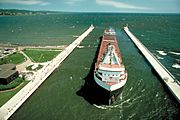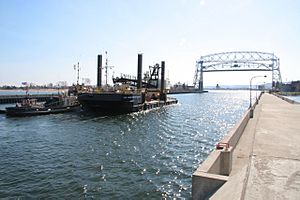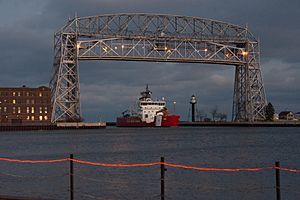Duluth Ship Canal facts for kids
Quick facts for kids Duluth Ship Canal |
|
|---|---|

SS Tarantau entering the Duluth Ship Canal from the lake. The two entrance lights can be seen at the end of the piers, while the museum building is at the extreme left.
|
|
| Specifications | |
| Locks | none |
| Status | Open |
| History | |
| Original owner | US Federal Government |
| Construction began | 1870 |
| Date completed | 1871 |
The Duluth Ship Canal is a special waterway built by people. It cuts through a long piece of land called Minnesota Point. This canal gives ships direct access to the Duluth harbor from Lake Superior.
Work on the canal started in 1871 by private groups. A few years later, the United States government took over its care. Today, it's still a very important part of the harbor.
The canal has two long walls, called breakwaters. They are about 1,720 feet (524 meters) long and 300 feet (91 meters) apart. These walls are made of concrete built on timber and stone. The canal is kept 245 feet (75 meters) wide and 28 feet (8.5 meters) deep. This allows large ocean-going ships to pass through.
Three lighthouses guide ships. The Duluth North Pier Light and the Duluth South Breakwater Outer Light are at the lake end. The Duluth South Breakwater Inner Light works with the south breakwater light to help ships line up correctly. At the harbor end, the famous Aerial Lift Bridge crosses over the canal. This bridge connects Minnesota Point to the rest of Duluth.
On the north side of the canal, there's a building for the U.S. Army Corps of Engineers. This building also has the Lake Superior Maritime Visitor Center, which is a museum. The canal doesn't have any locks. Most ships use their own power to go through. Sometimes, if the weather is bad, tugboats help. About a thousand ships use the Duluth–Superior port each year.
Contents
Why Was the Canal Built?
In 1855, new locks were built on the St. Marys River. These locks made it possible for ships to travel between the Great Lakes. Superior Bay became a good place for a harbor.
However, for people in Duluth, getting to the lake was tricky. Ships from Duluth had to pass by Superior, Wisconsin. This was because the only natural way out to the lake was far away. It was between Minnesota Point and Wisconsin Point. Also, even though the bay was calm, it wasn't naturally deep enough for big ships. The path was also winding and difficult.
In 1865, a harbor was built outside the bay using a breakwater. This was improved over several years. But a big storm in 1871 destroyed it. It was rebuilt the next year but was later given up in 1878. This was because of constant damage from ice and storms.
Duluth Digs Its Own Canal
In 1866, an army report suggested digging a canal through Minnesota Point. But it was too expensive, so nothing happened. Instead, the government spent a lot of money to improve facilities in Superior, Wisconsin.
At the same time, the city of Duluth decided to take action. They teamed up with the Lake Superior and Mississippi Railroad to dig their own canal. Work started in 1870.
Politicians in Wisconsin worried that this canal would take away ship traffic from Superior. They asked the government to stop the construction. They even got a court order on July 13, 1871, to halt the work. But it was too late!
The canal was finished two months earlier. A popular local story says that on April 30, 1871, many Duluth citizens gathered. They were called by a local brewer named Sidney Luce. They came with shovels and picks and dug the very first connection between the bay and the lake.
Federal Control and Challenges
The court order to stop construction was soon lifted. But Duluth had to agree to build a dike from Rice's Point to Minnesota Point. This dike was meant to separate the canal from the main flow of the Saint Louis River. This river fed the bay and formed the border between Duluth and Superior.
However, the dike didn't last long. It was damaged by ice from the start. It was slowly removed as the canal was dredged. In 1873, the government took responsibility for dredging. This gradually led to the U.S. Army Corps of Engineers taking control of the canal in 1887. They still manage it today.
In 1889, a businessman named Wilhelm Boeing tried to charge ships for using the canal. Boeing owned land on both sides of the canal. He was the father of William Boeing, who later founded the famous aircraft company. Boeing's lawyer even stretched a rope across the canal entrance to claim the right to collect tolls. Nothing came of this.
The next October, flyers were sent to shipping companies. They said a rope would be stretched across the canal on the 15th of the month. This would stop all ships from passing. It's not clear what Boeing really planned or if he carried out his threat. But he died the next month, and the issue ended.
Modernizing the Canal
From the beginning, the canal had piers along its sides. These were first made of timber by the city, with some government money. But they couldn't stand up to the harsh winter weather. They needed a lot of repairs every few years.
In 1896, a big project began to rebuild the canal. This project gave the two piers their current look. The new south pier was finished in 1901. The north pier was completed the following year.
In 1906, the current administration building was finished. This building was made bigger in the 1940s. A visitor's center and museum were added to it in 1973. A maintenance yard was also built on the south side of the canal. The Aerial Lift Bridge was built in 1905. It was needed to connect Minnesota Point to the mainland. The canal had cut off the point from the rest of the city.



